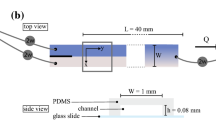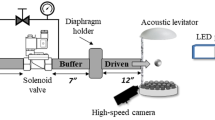Abstract
WHEN a thin stream of certain solutions of polyisobutylene in dekalin is poured on to an open evaporating dish, a heap of the liquid forms at the point of contact with the dish. As pouring proceeds a small streamer of liquid emerges from the heap, leaving it at a low trajectory, which gradually steepens before the streamer collapses. The whole effect lasts for about one second1–3. Using a new filming technique and a film speed of 250 frames s−1, we have observed that the emergent streamer is really a loop of liquid, and we here propose a mechanism for this effect. The second frame in Fig. 1 shows the effect. Such looping of the emergent streamer is not unexpected as the liquid is pituitous. In the following frames the loop extends outwards until the bottom of it strikes the surface of the liquid on the flat glass plate. As the streamer is cutting off the liquid from the heap, the heap collapses and flattens, presenting a smaller angle of incidence to the incident stream and causing the bouncing streamer to steepen in trajectory and move azimuthally, as suggested by Kaye. The base of the streamer's trajectory is often as large as 100 mm.
Similar content being viewed by others
References
Kaye, A., Nature, 197, 100–102 (1963).
Lodge, A. S., Elastic Liquids, 250–251 (Academic, London, 1964).
Collyer, A. A., Phys. Ed., 8, 111–116 (1973).
Author information
Authors and Affiliations
Rights and permissions
About this article
Cite this article
COLLYER, A., FISHER, P. The Kaye effect revisited. Nature 261, 682–683 (1976). https://doi.org/10.1038/261682a0
Received:
Accepted:
Published:
Issue Date:
DOI: https://doi.org/10.1038/261682a0
- Springer Nature Limited
This article is cited by
-
High-speed imaging in fluids
Experiments in Fluids (2013)





